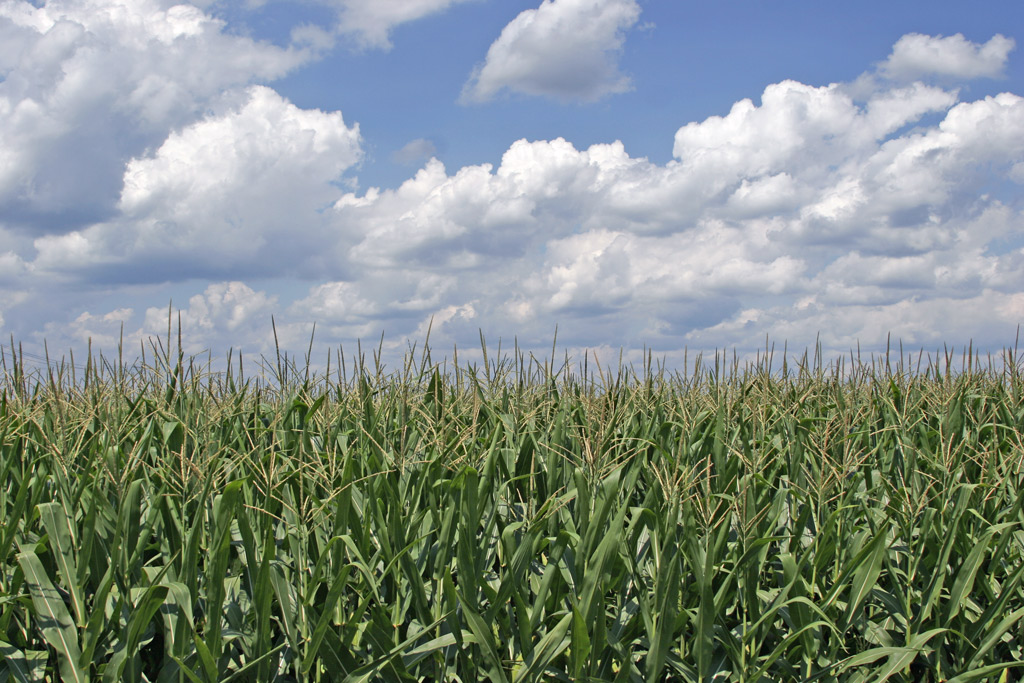May 2013
 |
| Corn growing in Ohio by Graylight (Flickr) [CC-BY-2.0 (http://creativecommons.org/licenses/by/2.0)] via Wikimedia Commons |
The results of a unique US agronomic
study have been released. Two different commercial maize crops grown
in fields with different management histories were tested for
composition. One crop was a GM herbicide-tolerant variety in a
no-till field treated with glyphosate (Roundup) for the past 10
years. The other was a conventional variety in a field which hadn't
been sprayed with Roundup during the previous 5 years. The two
fields were separated by a fence. Environmental stresses on the
crops were not unusually high that year.
Compositional analysis was by the 'gold
standard' technique of chromatographic separation followed by mass
spectrometry to identify the components. (Note that such analysis
identifies specific substances, not the broad nutrient categories
routinely used to assess the animal feeding value of crops.)
As expected, the GM
crops had accumulated glyphosate levels equal to the recently set US
maximum residue level. Also as expected (because glyphosate is known
to bind to certain substances making them unavailable) the GM crop
had lower levels of essential mineral nutrients.
Because the two
crops were genetically different cultivars, it would be unlikely for
their nutrient to be the same. However, the extent of the difference
was extreme: with one single exception out of the fourteen minerals
measured, the conventional maize had levels six to four-hundred times
higher than the GM crop.
Even more
unexpected was the discovery of high readings of formaldehyde in the
GM maize. None was detected in the conventional one.
Formaldehyde in free chemical form is better known as embalming fluid. It's a mutagen, a suspected carcinogen, a neurotoxin, and it induces changes in proteins similar to the abnormalities found in Alzheimer's disease. Formaldehyde arises as a normal, but closely controlled, biochemical intermediate during plant and animal cell processes, but doesn't exist in the free-state in a healthy organism.
This raises the question of whether
some metabolic disturbance of the genetically transformed plants is
leading to an imbalance resulting in an unnatural accumulation of
formaldehyde.
Another possibility is that, since the
zinc level in the GM crop was only 16% of the conventional one and
the natural detoxification of formaldehyde involves a zinc-dependent
enzyme, the glyphosate-infused GM plants may be failing to remove the
toxin as it arises.
Possibly more sinister is that
glyphosate itself can be used as a nutrient source by some common
soil and plant bacteria, with formaldehyde as a major by-product.
The roots of GM plants are known to
exude the glyphosate previously absorbed through the leaves out into
the soil. Bacteria subject to long-term, continuous exposure to the
herbicide, as in a no-till/glyphosate-tolerant crop system, will be
under pressure to evolve metabolic pathways to use glyphosate. And,
soil microbes living around the roots can have highly dynamic and
adaptive genomes.
Add to this that plant roots tend to
attract useful soil bacteria into the area immediately around
themselves. GM crops with a high glyphosate content could be
actively accumulating bacteria which generate formaldehyde to deal
with the excess weed-killer and protect their own health.
What effects could formaldehyde in the
diet have?
The Institute of Science in Society
notes that:
“Scientific evidence on glyphosate accumulated over three decades documents miscarriages, birth defects, carcinogenesis, endocrine disruption, DNA damage, neurotoxicity, and toxicity to liver and kidney at levels well below recommended agricultural use.”
A US crop nutrition adviser commented
that a glyphosate/formaldehyde link could “explain the continuing
problems we are witnessing in livestock operations with poor animal
health when GM feed stuffs are in the diet”.
It could also explain the Danish
pig-farmer whistle-blower's observations [1]
Seemingly oblivious to this and to the
many scientific questions which have surfaced regarding, for example,
foetal abnormalities [2], cancer [3] digestive system impairment [4],
and chromosome disruption [5], the US Environmental Protection Agency
is considering a substantial increase in the allowed glyphosate
residues in food, feed and oils.
WHAT YOU CAN DO
Unless you want to eat livestock
embalmed on the hoof or risk being prematurely preserved yourself, it
would be a very good idea to demand that the question of formaldehyde
accumulation in both herbicide-tolerant crops and crops from
continuous no-till systems be fully explored.
Background
reading:
[1] DANISH PIG FARMER WHISTLE-BLOWER - May 2012
[2] ROUNDUP CAUSES BIRTH-DEFECTS - GMFS Archive, October 2010
[3] GM MAIZE IS NOT SAFE TO EAT - October 2012
[4] HOW GM FOODS COULD BE ATTACKING YOU FROM THE INSIDE - January 2013
[5] ARGENTINEAN DOCTORS REPORT ON PESTICIDE EFFECTS - November 2011
SOURCES:
- US EPA hikes glyphosate limits in food and feed - again, GM Watch 3.05.13
- Dr. Mae-Wan Ho, “Stunning” Differences of GM from non-GM Corn, Institute of Science in Society Report, 22.04.13
- Andrew L. Neal et al., April 2012, Benzoxazinoids in Root Exudates of Maize Attract Pseudomonas putida to the Rhizoshpere, PLOS ONE 7(4)
- H. E. O'Brien et al., 2011, Evolution of plant pathogenesis in Pseudomonas syringae: a genomics perspective, Annual Review of Phytopathology
- D. L. Shinabarger and H. D. Braymer, 1986, Glyphosate catabolism by Pseudomonas sp. strain PG2982, Journal of Bacteriology 168(2)
Can you please provide the reference of this scientific paper?
ReplyDeleteHello Lieve. All the sources at listed at the bottom of the article.
ReplyDelete